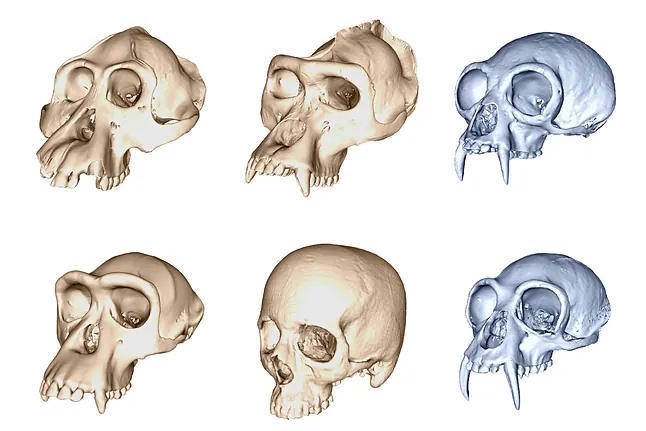In 2025, there are still questions to be clarified about the human brain, a true marvel of evolution. In addition to the mysteries in the field of neuroscience, some of the keys that explain what makes us human reside in this organ. A new study conducted by scientists from University College London (UCL) provides new information on this matter.
According to this research, led by Spanish scientist Aída Gómez-Robles and published this Tuesday, the human brain evolved much faster than that of the other great apes. To reach this conclusion, the team examined three-dimensional virtual models of the skulls of different modern primate species, specifically, seven hominids or great apes - humans, chimpanzees, bonobos, the two species of gorillas (western and eastern), and the two species of orangutans (Bornean and Sumatran) - and compared them with nine species of gibbons, considered lesser apes or hylobatids.
As detailed in the journal Proceedings of the Royal Society B, hominids and hylobatids (gibbons) diverged evolutionarily about 20 million years ago. During that time, the anatomical diversity of hominids skyrocketed, while that of gibbons remained surprisingly limited. As a result, the skulls of different gibbon species closely resemble each other, while hominid species are considerably distinct. However, even within this group, humans evolved faster than other species.
Most great apes currently have large and prominent faces with relatively small brains, while humans have flatter faces and large, round heads. Gibbons, in some aspects similar to humans, also have relatively flat faces and a round head, but a much smaller brain.
The analysis by this team shows that humans developed large brains and flat faces at a surprisingly fast rate compared to other apes, reflecting the evolutionary advantages of these traits.
"This result is not necessarily surprising, as human skulls are very different from those of great apes. However, our study is the first to quantify the speed at which different species have evolved, demonstrating that the human skull has evolved twice as fast as would be expected if there were no selective pressure, meaning if there were no specific reason driving its change during the evolution of our species," explains Aída Gómez-Robles via email.
These adaptations, the authors say, may be related to the cognitive advantages of having a large brain, but there could also be social factors influencing our evolution. "The evolutionary benefits of having a large brain are probably related to the cognitive abilities associated with brain size. From that perspective, it is easy to understand that the human skull has evolved faster because having a larger brain confers evolutionary advantages related to greater intelligence and more complex behavior. However, our study also shows that the human face has evolved as fast as the neurocranium," explains the researcher.
Initially, she clarifies, "this could be because brain expansion and facial flattening are related during development, but that does not seem to be the case because in other species we do not see a clear relationship between the speed at which the neurocranium evolves and the speed at which the face evolves. Therefore, we can infer that there is a different selective pressure causing the human face to evolve faster than expected as well".
Thus, Gómez-Robles explains, "the face is the interface through which we interact with other people, so a possible explanation is that the selective pressures that have caused it to evolve faster than expected are related to how we interact with other individuals in our social group."
Some researchers, she reviews, have suggested that these facial modifications are related to a process of self-domestication that would involve a reduction in the level of aggression within human groups and a general gracilization of the face: "Our study does not explicitly test this hypothesis, but this is an example of the type of social factor that could influence facial variation in humans."
According to the author, the most striking result of her research "is that factors related to social interactions between individuals can exert a selective pressure as strong as elements linked to increased brain size and intelligence."
